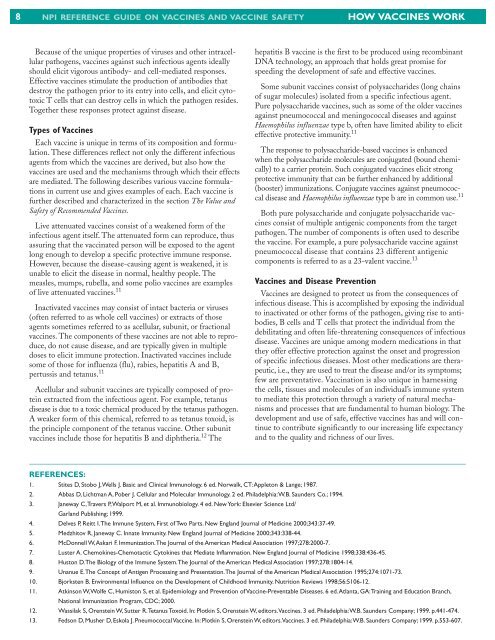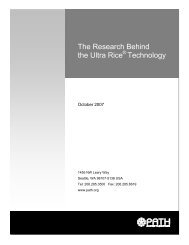How Vaccines Work - PATH
How Vaccines Work - PATH
How Vaccines Work - PATH
You also want an ePaper? Increase the reach of your titles
YUMPU automatically turns print PDFs into web optimized ePapers that Google loves.
8 NPI REFERENCE GUIDE ON VACCINES AND VACCINE SAFETY<br />
Because of the unique properties of viruses and other intracellular<br />
pathogens, vaccines against such infectious agents ideally<br />
should elicit vigorous antibody- and cell-mediated responses.<br />
Effective vaccines stimulate the production of antibodies that<br />
destroy the pathogen prior to its entry into cells, and elicit cytotoxic<br />
T cells that can destroy cells in which the pathogen resides.<br />
Together these responses protect against disease.<br />
Types of <strong>Vaccines</strong><br />
Each vaccine is unique in terms of its composition and formulation.<br />
These differences reflect not only the different infectious<br />
agents from which the vaccines are derived, but also how the<br />
vaccines are used and the mechanisms through which their effects<br />
are mediated. The following describes various vaccine formulations<br />
in current use and gives examples of each. Each vaccine is<br />
further described and characterized in the section The Value and<br />
Safety of Recommended <strong>Vaccines</strong>.<br />
Live attenuated vaccines consist of a weakened form of the<br />
infectious agent itself. The attenuated form can reproduce, thus<br />
assuring that the vaccinated person will be exposed to the agent<br />
long enough to develop a specific protective immune response.<br />
<strong>How</strong>ever, because the disease-causing agent is weakened, it is<br />
unable to elicit the disease in normal, healthy people. The<br />
measles, mumps, rubella, and some polio vaccines are examples<br />
of live attenuated vaccines. 11<br />
Inactivated vaccines may consist of intact bacteria or viruses<br />
(often referred to as whole cell vaccines) or extracts of those<br />
agents sometimes referred to as acellular, subunit, or fractional<br />
vaccines. The components of these vaccines are not able to reproduce,<br />
do not cause disease, and are typically given in multiple<br />
doses to elicit immune protection. Inactivated vaccines include<br />
some of those for influenza (flu), rabies, hepatitis A and B,<br />
pertussis and tetanus. 11<br />
Acellular and subunit vaccines are typically composed of protein<br />
extracted from the infectious agent. For example, tetanus<br />
disease is due to a toxic chemical produced by the tetanus pathogen.<br />
A weaker form of this chemical, referred to as tetanus toxoid, is<br />
the principle component of the tetanus vaccine. Other subunit<br />
vaccines include those for hepatitis B and diphtheria. 12 The<br />
HOW VACCINES WORK<br />
hepatitis B vaccine is the first to be produced using recombinant<br />
DNA technology, an approach that holds great promise for<br />
speeding the development of safe and effective vaccines.<br />
Some subunit vaccines consist of polysaccharides (long chains<br />
of sugar molecules) isolated from a specific infectious agent.<br />
Pure polysaccharide vaccines, such as some of the older vaccines<br />
against pneumococcal and meningococcal diseases and against<br />
Haemophilus influenzae type b, often have limited ability to elicit<br />
effective protective immunity. 11<br />
The response to polysaccharide-based vaccines is enhanced<br />
when the polysaccharide molecules are conjugated (bound chemically)<br />
to a carrier protein. Such conjugated vaccines elicit strong<br />
protective immunity that can be further enhanced by additional<br />
(booster) immunizations. Conjugate vaccines against pneumococcal<br />
disease and Haemophilus influenzae type b are in common use. 11<br />
Both pure polysaccharide and conjugate polysaccharide vaccines<br />
consist of multiple antigenic components from the target<br />
pathogen. The number of components is often used to describe<br />
the vaccine. For example, a pure polysaccharide vaccine against<br />
pneumococcal disease that contains 23 different antigenic<br />
components is referred to as a 23-valent vaccine. 13<br />
<strong>Vaccines</strong> and Disease Prevention<br />
<strong>Vaccines</strong> are designed to protect us from the consequences of<br />
infectious disease. This is accomplished by exposing the individual<br />
to inactivated or other forms of the pathogen, giving rise to antibodies,<br />
B cells and T cells that protect the individual from the<br />
debilitating and often life-threatening consequences of infectious<br />
disease. <strong>Vaccines</strong> are unique among modern medications in that<br />
they offer effective protection against the onset and progression<br />
of specific infectious diseases. Most other medications are therapeutic,<br />
i.e., they are used to treat the disease and/or its symptoms;<br />
few are preventative. Vaccination is also unique in harnessing<br />
the cells, tissues and molecules of an individual’s immune system<br />
to mediate this protection through a variety of natural mechanisms<br />
and processes that are fundamental to human biology. The<br />
development and use of safe, effective vaccines has and will continue<br />
to contribute significantly to our increasing life expectancy<br />
and to the quality and richness of our lives.<br />
REFERENCES:<br />
1. Stites D, Stobo J,Wells J. Basic and Clinical Immunology. 6 ed. Norwalk, CT:Appleton & Lange; 1987.<br />
2. Abbas D, Lichtman A, Pober J. Cellular and Molecular Immunology. 2 ed. Philadelphia:W.B. Saunders Co.; 1994.<br />
3. Janeway C,Travers P,Walport M, et al. Immunobiology. 4 ed. New York: Elsevier Science Ltd/<br />
Garland Publishing; 1999.<br />
4. Delves P, Reitt I.The Immune System, First of Two Parts. New England Journal of Medicine 2000;343:37-49.<br />
5. Medzhitov R, Janeway C. Innate Immunity. New England Journal of Medicine 2000;343:338-44.<br />
6. McDonnell W,Askari F. Immunization.The Journal of the American Medical Association 1997;278:2000-7.<br />
7. Luster A. Chemokines-Chemotactic Cytokines that Mediate Inflammation. New England Journal of Medicine 1998;338:436-45.<br />
8. Huston D.The Biology of the Immune System.The Journal of the American Medical Association 1997;278:1804-14.<br />
9. Unanue E.The Concept of Antigen Processing and Presentation.The Journal of the American Medical Association 1995;274:1071-73.<br />
10. Bjorksten B. Environmental Influence on the Development of Childhood Immunity. Nutrition Reviews 1998;56:5106-12.<br />
11. Atkinson W,Wolfe C, Humiston S, et al. Epidemiology and Prevention of Vaccine-Preventable Diseases. 6 ed.Atlanta, GA:Training and Education Branch,<br />
National Immunization Program, CDC; 2000.<br />
12. Wassilak S, Orenstein W, Sutter R.Tetanus Toxoid. In: Plotkin S, Orenstein W, editors.<strong>Vaccines</strong>. 3 ed. Philadelphia:W.B. Saunders Company; 1999. p.441-474.<br />
13. Fedson D, Musher D, Eskola J. Pneumococcal Vaccine. In: Plotkin S, Orenstein W, editors.<strong>Vaccines</strong>. 3 ed. Philadelphia:W.B. Saunders Company; 1999. p.553-607.

















